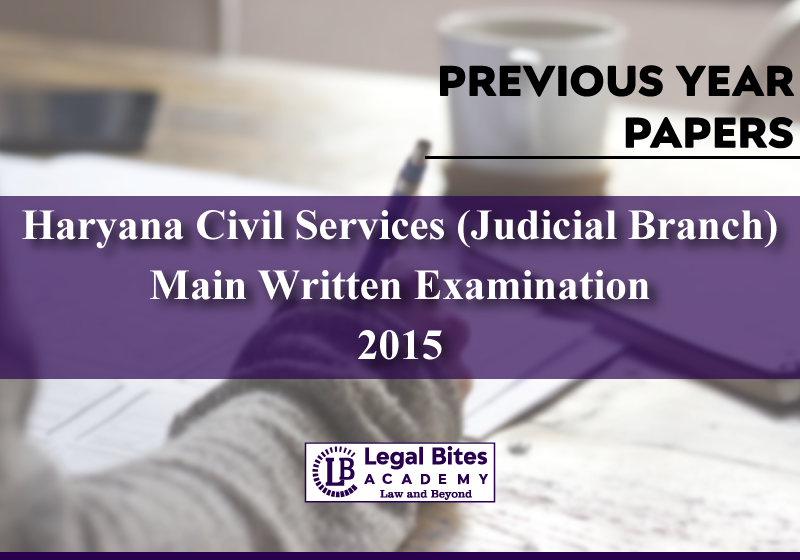Haryana Judicial Services Mains 2015 Previous Year Paper (Civil Law-I)
Candidates preparing for Haryana Judicial Services should solve the Haryana Judicial Services Mains 2015 Previous Year Paper and other previous year question papers before they face Prelims and Mains. Additionally, it gives an idea about the syllabus and the way to prepare the subjects by keeping the previous year questions in mind. All toppers are mindful and cognizant… Read More »

Candidates preparing for Haryana Judicial Services should solve the Haryana Judicial Services Mains 2015 Previous Year Paper and other previous year question papers before they face Prelims and Mains.
Additionally, it gives an idea about the syllabus and the way to prepare the subjects by keeping the previous year questions in mind. All toppers are mindful and cognizant of the types of questions asked by the HCS, to be aware of the various different tricks and types of questions. This should be done by every aspirant when starting their preparation. It is very important to have an overall understanding of the pattern and design of questions.
Only practising the authentic question papers will give you a real feel of the pattern and style of the questions. Here’s Haryana Judicial Services Mains 2015 Previous Year Paper (Civil Law-I).
Haryana Civil Services (Judicial Branch) Main Written Examination 2015
CIVIL LAW-I
Time: 3 Hours
Maximum Marks: 200
Instructions:
- Attempt all the questions in the same order in which they appear in the Question Paper.
- Marks for individual questions are indicated against each question.
- Support your answers with relevant provisions and case law.
- No extra answer sheet will be provided.
Question 1
A. What is a preliminary decree and in what cases such a decree is passed? Enumerate the types of suits in which the Code of Civil Procedure provides for passing of a preliminary decree. (20 marks)
B. Can two preliminary decrees be passed in a suit? Explain with illustration. (10 marks)
C. Can two final decrees be passed in one civil suit? Elucidate. (10 marks)
Question 2
A. What is the basic principle in deciding amendment application filed by plaintiff? At which stage such an application can be allowed by the court? (10 marks)
B. Does the court has the power to strike out the pleading of the parties to a suit. If yes, then what are the grounds on which such power can be exercised by the Court? (10 marks)
C. What is meant by alternate and inconsistent pleadings? Can the parties to a suit incorporated both of these pleadings at the same time? (10 marks)
D. ‘A’ files a suit for recovery of one lac rupees against ‘B’ Can ‘B’ claim a set off against ‘A’ and ‘C’ jointly in his written statement? (10 marks)
Question 3
A. What is the importance of “ready and willingness to perform “in a suit for specific performance? What happens when the plaintiff has not averred his readiness and willingness to perform in his pleading? (10 marks)
B. Can a Court grant part performance of a contract on the option of (i) plaintiff (ii) plaintiff and defendant both or (iii) defendant only? At what stage of litigation can part performance of contract be accepted by a party? (10 marks)
C. What are the limits within which a court may permit rectification? Whether the relief in this regard is discretionary or mandatory upon the court? (10 marks)
D. How can a contract be rescinded by a party to it in case the other party is not available and can’t be served notice? (10 marks)
Question 4
A. “Every promise is an agreement.” Examine the validity of this statement in light of the Indian Contract Act, 1872. (10 marks)
B. Tarun who is the owner of a mountain bicycle writes a letter to Satish on March 15, offering to sell him his bicycle for 50,000/-. The letter also mentions that the offer will be open till 20th March 2015. On 18th March 2015 at 3:50 pm. Satish posts a letter of acceptance to buy the bicycle which reaches Tarun at 8:30 pm. The same day. Before that at 1:10 pm. Tarun has already posted a letter of revocation with reaches Satish at 5:30 pm. Critically examine whether a binding contract has been entered between Satish and Tarun citing relevant provisions of the Indian Contract Act, 1872. (10 marks)
C. What are the rights of an unpaid seller under the Sale of Goods Act? How and when can such rights be exercised? Also, state briefly the consequences of the exercise of such rights by the unpaid seller. (10 marks)
D. What are the circumstances that could lead to the dissolution of a partnership firm? Does death of one of the partners dissolve the partnership firm automatically? In a situation where a partnership firm is constituted by two partners only what will be effect of the death of one of them on the partnership firm? (10 marks)
Question 5
A. What is Secondary evidence? Under what circumstances it can be given? Is uncertified copy of public document admissible if original has been destroyed? (10 marks)
B. A 28-year-old document is filed by the plaintiff in a suit. Document is exhibited in evidence after three years. Will any presumptions be available to such document in the said suit? (10 marks)
C. “The Rent Act regulates the incidence of the tenancy and inter se rights and obligations of the landlord and tenant”. Comment in the light of the provision of Haryana Urban (Control of Rent and Eviction) Act. (10 marks)
D. Write short notes on the following: (2×5 = 10 marks)
- Objective of the Punjab Courts Act, 1918.
- Fact-in-issue and relevant facts
- Leading questions
- Res gestae
- Disproved and not proved.

